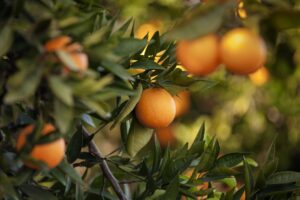
Eliza Tibbets helped introduce navel oranges to the United States back in the 19th century!
Navel oranges are among the most popular orange varieties around – and not just at Florida Indian River Groves. Our fundraisers offer delicious navel oranges as one of our fresh fruit options, and for a good reason: the navel orange is a sweet, versatile, and beautiful fruit. But where did they come from, and when did they become so beloved? Eliza Tibbets is considered the “Mother of Navel Oranges” because she helped popularize these fruits across the United States. If you are a fan of navel oranges like we are, read on to learn more about Eliza Tibbets and what makes navel oranges so great.
How Eliza Tibbets Became the Mother of Navel Oranges
Eliza Tibbets lived from 1823 to 1898 and, after living in Virginia and D.C., moved to the new town of Riverside, California, with her husband. The Riverside community built an irrigation channel to bring in water for crops. Eliza then wanted to grow a “cash crop” to support her family, so she contacted her friend William Saunders back in D.C. to see if he had any recommendations. Saunders was the head of the experimental gardens division of the U.S. Department of Agriculture (sounds fun!).
Saunders had been growing orange trees in D.C. and had acquired a few unique orange tree specimens from Bahia, Brazil. The oranges were “sterile,” with no seeds or pollen, so Saunders grafted twelve of these Bahia orange trees on young orange tree rootstock and sent two to Eliza.
California Orange Trees
Eliza then planted these navel orange trees next to her kitchen door and, according to the legend, nurtured them with dishwater. The trees soon thrived in the California climate and became known as Washington navel oranges, soon spreading in planting and popularity. These fruits helped California transition from a largely wheat-producing state to an orange-producing one.
Navel oranges that we know and love are grown on trees descended from Eliza’s two original trees. One of those trees is still alive and can even be visited!
Why We Love Navel Oranges
Navel oranges are seedless, making them much easier to eat for people of all ages. Their flesh is naturally sweet and juicy, and their rind is thick, making them easy to peel—fun fact: the “navel” on the fruit is a second, immature fruit.
These orange varieties are also very high in fiber, which can improve your cholesterol, regulate sugar levels in your body and help prevent colon cancer.
However, navel oranges are perhaps best loved for their primary nutritional ingredient, vitamin C. This is crucial because the human body doesn’t naturally produce vitamin C, so we need to find ways to obtain this helpful vitamin that can boost our immune systems and help the body absorb more iron.
Today, navel oranges in the United States are primarily grown in warm climates like Arizona, California, and, of course, Florida.
PLAN YOUR NEXT FUNDRAISER WITH FLORIDA INDIAN RIVER GROVES
Located in Vero Beach, Florida, Florida Indian River Groves is a proven leader in fruit sale fundraising. We’ve successfully raised over $87 million for schools, churches, and community groups throughout the United States. Florida Indian River Groves is especially popular among schools in the Southeast, with large numbers of clients in Tennessee, Georgia, North Carolina, South Carolina, and Virginia. Our fresh fruit, easy-to-use programs, and customer service cannot be beat. You can visit our website today to request more information, browse our varieties, or schedule a fundraiser. You may also speak to a representative at 1-800-468-3168 for more details. Follow our Facebook, LinkedIn, Twitter, Pinterest, and Instagram pages for updates on our fundraising programs and fresh fruit harvests.
